New Challenges in the Conservation of Fair-Faced Reinforced Concrete with Aesthetic Value: The Lessons from an Italian Brutalist Monument
Abstract
1. Introduction
- Assessing the present condition of the reinforced concrete’s surfaces and their main degradation mechanisms;
- Suggesting appropriate and low-invasive repair solutions which are compatible with the conservation principles.
2. The Monument and Its Deterioration
2.1. Description of the Monument
2.2. Preliminary Visual Survey of Materials and Their Deterioration
- Widespread material loss (Figure 3a);
- Corrosion of exposed steel reinforcements (Figure 3b);
- Ferruginous stains coming from the exposed reinforcement or possibly from reactive aggregates contained in concrete (Figure 3c);
- Copper and bronze salt stains on concrete resulting from the leaching of the copper/bronze statues (Figure 3d);
- Surface crumbling of concrete (Figure 3e);
- Biological colonisation of the concrete surface, with patinas’ formation (Figure 3f);
- Yellowing of concrete surface in the chapels (Figure 3a).
3. Materials and Methods
3.1. Archival Research
3.2. Samples
3.3. Characterisation Techniques
- To assess if the rough surface of the Monument (Figure 6a,d) is due to an acid wash or to a chisel treatment, the latter described in the construction’s records [23]. The idea that an acid wash was carried out to obtain a rough surface in concrete was suggested by Fondazione Cesare Gnudi [13]. If used, this treatment could have contributed to deterioration by the formation of harmful soluble salts. Therefore, samples 3b and 7 were analysed by ion chromatography in a Dionex ICS 1000 (Thermo Fisher Scientific, Waltham, MA, USA), after grinding, addition to boiling deionised water for 10 min under stirring and filtration.
- To investigate the cause of the ochre-yellow colour of the surface of the funeral chapels (Figure 6b,c), and to assess if it was originally prescribed by Bottoni (hence, possibly worthy of conservation) or is the result of some deterioration (hence, to be cleaned). Therefore, two cross-sections were prepared from samples 1 and 2 and observed in a stereoscopical optical microscope (SOM, SZX10, Olympus Corporation’s Scientific Solutions, Center Valley, PA, USA). Samples 1 and 2 were also studied in terms of chemical-mineralogical composition by FT-IR spectrometry in a Nicolet Avatar 360 (Thermo Fisher Scientific, USA) equipped with ATR cells and by X-ray diffraction (XRD) in an Empyrean (Malvern Panalytical, United Kingdom) equipped with a CuKα tube operating at 40 kV and 30 mA, using a 2θ range from 4° to 80° and a step size of 0.026°. Both analyses were performed on dried powder (milled samples). The XRD analysis was chosen because the Monument under study is complex and was conceived by the architect as a work of art. For this reason, the composition of the concrete used was not obvious and needed to be investigated, differently from ordinary concrete structures where other characterisation techniques are currently applied.
- To investigate the nature of salt efflorescence on the surface of the crypt (Figure 6d), and to identify their origin and possible contribution to concrete deterioration. The presence of soluble salts in samples 4, 5 and 6 was investigated by ion chromatography, in a Dionex ICS 1000, after addition to boiling deionised water for 10 min under stirring and filtration.
- To investigate and quantify the porosity of the cement mortar fraction. Porosity is a key parameter used to evaluate the deterioration and vulnerability of concrete and to select compatible conservation solutions. Therefore, the water absorption of samples 1, 2, 3b, and 7 was determined by the water absorption test (UNI 7699:2018 [24]) measuring the dry and saturated masses of the samples. To evaluate the saturated mass, the samples were immersed in deionised water first for half their volume and then submerged for 72 h.
- To evaluate the quality of the aggregates used in the concrete of the ossuary which are directly exposed to the external environment (Figure 5b) and which exhibit local cracks. Therefore, sample 3a was observed in a stereoscopical optical microscope (SOM) and it was also characterised in terms of chemical–mineralogical composition by X-ray diffraction (XRD) to detect the possible presence of undesirable products. It would be useful to study also the concrete mix, i.e., cement type and cement–aggregate ratio, but it could not be performed in this study because of limitations on sampling. An investigation of this issue could be carried out in the future, as no information on the concrete mix was found in the archival documents.
4. Results and Discussion
4.1. The Use of Fair-Faced Reinforced Concrete and the Building Techniques
4.2. Laboratory Analyses of Samples
5. Guidelines for Conservation
- Concrete was prepared with poor awareness of durability issues and hence, exhibits high porosity, probably due to a high w/c ratio. This high porosity led to fast and deep carbonation and low resistance to frost. The concrete aggregates seem not particularly durable as well.
- For the same reason, the concrete cover used in the structure is too thin and carbonation has already reached the reinforcement, which is exposed in wide zones. Also based on previous tests, all the reinforcement can be considered not passivated any more even in areas where the concrete cover is still there.
- The roughness of concrete promotes soiling and water accumulation and the formation of biological colonisation, whose growth inside the ossuary is enhanced by the dark and shadowed environment.
- Infiltration of water from the surrounding soil across the concrete structure is occurring, leading to efflorescence (mostly harmful sulphate).
6. Conclusions
- According to the original archive documents, the different surface textures of the concrete in the Monument and the surrounding chapels were designed by Piero Bottoni himself and were identified as original features characterising this structure. Hence, they constitute the main element of value to be preserved in any restoration work.
- The original materials’ manufacturing was affected by a poor awareness of reinforced concrete’s durability issue and a low familiarity of workmanship with concrete used for artistic purposes, resulting in a generalised low quality of constructive details and materials and in the presence of defects.
- The onsite inspections and laboratory analyses revealed that the concrete is heavily deteriorated by the following: carbonation and reinforcement corrosion; physical-mechanical decay due to high porosity of concrete; staining due to copper and iron salts leaching and deterioration of disarming oils used in the concrete’s frameworks; extensive and severe biological deterioration and colonisation, exacerbated by the high concrete roughness; and water infiltration.
Supplementary Materials
Author Contributions
Funding
Data Availability Statement
Acknowledgments
Conflicts of Interest
References
- Collepardi, M.; Ogoumah Olagot, J.J.; Simonelli, F.; Troli, R. Il Calcestruzzo Vulnerabile: Prevenzione, Diagnosi del Degrado e Restauro; Tintoretto: Villorba, Italy, 2005; pp. 79–82. [Google Scholar]
- Docomomo International. The Fair Face of Concrete: Conservation and Repair of Exposed Concrete; Dossier 2; Eindhoven University of Technology printshop: Eindhoven, The Netherlands, 1998. [Google Scholar]
- Franzoni, E.; Varum, H.; Natali, M.E.; Bignozzi, M.C.; Melo, J.; Rocha, L.; Pereira, E. Improvement of historic reinforced concrete/mortars by impregnation and electrochemical methods. Cem. Concr. Comp. 2014, 34, 50–58. [Google Scholar] [CrossRef]
- ISC20C ICOMOS. Madrid—New Delhi Document. Approaches to the Conservation of Twentieth-Century Cultural Heritage. 2017. Available online: https://openarchive.icomos.org/id/eprint/2677/ (accessed on 19 April 2025).
- Carmona-Quiroga, P.M.; Pachón-Montaño, A.; Queipo-de-Llano, J.; Martín-Caro, J.A.; López, D.; Paniagua, I.; Martínez, I.; Rubiano, F.; García-Lodeiro, I.; Fernández-Ordóñez, L.; et al. Characterisation and diagnosis of heritage concrete: Case studies at the Eduardo Torroja Institute, Madrid, Spain. Mater. Constr. 2021, 71, e262. [Google Scholar] [CrossRef]
- Miranda, J.; Valença, J.; Costa, H.; Júlio, E. Methodology for the restoration of heritage built in exposed concrete. The case study of ‘Piscina das Marés’, Portugal. Constr. Build. Mater. 2022, 328, 127040. [Google Scholar] [CrossRef]
- Franzoni, E.; Pizzigatti, C. Onsite and laboratory assessment of repair mortars for reinforced concrete floor slabs in heritage buildings. Front. Mater. 2024, 11, 1370921. [Google Scholar] [CrossRef]
- Zarzuela, R.; Luna, M.; Coneo, J.G.; Gamelli, G.; Andreouli, D.; Kaloidas, V.; Mosquera, M.J. Multifunctional silane-based superhydrophobic/impregnation treatments for concrete producing C-S-H gel: Validation on mockup specimens from European heritage structures. Constr. Build. Mater. 2023, 367, 130258. [Google Scholar] [CrossRef]
- Redaelli, E.; Lollini, F.; Bertolini, L. Throwing power of localized anodes for the cathodic protection of slender carbonated concrete elements in atmospheric conditions. Constr. Build. Mater. 2013, 39, 95–104. [Google Scholar] [CrossRef]
- Pizzigatti, C.; Franzoni, E. The problem of conservation of XX century architectural heritage: The fiberglass dome of the Woodpecker dance club in Milano Marittima (Italy). J. Build. Eng. 2021, 42, 102476. [Google Scholar] [CrossRef]
- Consonni, G. Piero Bottoni a Bologna e a Imola. Città, Casa, Monumento 1934–1969; Ronca Editore: Cremona, Italy, 2003. [Google Scholar]
- Decreto Legislativo 22 gennaio 2004, n. 42. Codice dei Beni Culturali e del Paesaggio; Gazzetta Ufficiale della Repubblica Italiana: Rome, Italy, 2004. [Google Scholar]
- Fondazione Cesare Gnudi. Monumento Ossario ai Caduti Partigiani alla Certosa di Bologna: Analisi Scientifiche Finalizzate alla Conservazione e al Restauro; Fondazione Cesare Gnudi: Bologna, Italy, 2001. [Google Scholar]
- Piero Bottoni Archive (Dastu, Politecnico di Milano). op.354.2, Diapositive a Colori, Diapositiva n.04; Piero Bottoni Archive (Dastu, Politecnico di Milano): Milano, Italy, undated.
- Piero Bottoni Archive (Dastu, Politecnico di Milano). op.354.2, Fotografie, Fotografia 11; Piero Bottoni Archive (Dastu, Politecnico di Milano): Milano, Italy, undated.
- Piero Bottoni Archive (Dastu, Politecnico di Milano). op.354.2, Fotografie, Fotografia 39; Piero Bottoni Archive (Dastu, Politecnico di Milano): Milano, Italy, undated.
- Piero Bottoni Archive (Dastu, Politecnico di Milano). op.354.1, Fotografie, Fotografia 015; Piero Bottoni Archive (Dastu, Politecnico di Milano): Milano, Italy, undated.
- Piero Bottoni Archive (Dastu, Politecnico di Milano). op.354.1, Fotografie, albg.n.13 p.22; Piero Bottoni Archive (Dastu, Politecnico di Milano): Milano, Italy, undated.
- Piero Bottoni Archive (Dastu, Politecnico di Milano). op.354.2, Fotografie, Fotografia 5; Piero Bottoni Archive (Dastu, Politecnico di Milano): Milano, Italy, undated.
- Piero Bottoni Archive (Dastu, Politecnico di Milano). op.354.2, Fotografie, Fotografia 20; Piero Bottoni Archive (Dastu, Politecnico di Milano): Milano, Italy, undated.
- Piero Bottoni Archive (Dastu, Politecnico di Milano). op.354.2, Fotografie, Fotografia 58; Piero Bottoni Archive (Dastu, Politecnico di Milano): Milano, Italy, undated.
- EN 12504-1: 2021; Testing Concrete in Structures—Part 1: Cored Specimens—Taking, Examining and Testing in Compression. CEN-CENELEC Management Centre: Brussels, Belgium, 2021.
- Bologna Historical Archive. Tit.VIII, Rub.4, N.C.4002, 1954, P.N.14116/55, Relazione e Capitolato Speciale di Appalto; Bologna Historical Archive: Bologna, Italy, 1954. [Google Scholar]
- UNI 7699: 2018; Testing Hardened Concrete—Determination of Water Absorption at Atmospheric Pressure. Ente Nazionale Italiano di Unificazione (UNI): Milano, Italy, 2018.
- Bologna Historical Archive. Tit.VIII, Rub.4, N.C.4002, 1954, Disegno 1; Bologna Historical Archive: Bologna, Italy, 1954. [Google Scholar]
- Piero Bottoni Archive (Dastu, Politecnico di Milano). op.354.2, Disegni, Disegno 11; Piero Bottoni Archive (Dastu, Politecnico di Milano): Milano, Italy, 1963. [Google Scholar]
- Niebrzydowski, W. From “As Found” to Bush-Hammered Concrete—Material and Texture in Brutalist Architecture. Conf. Ser. Mater. Sci. Eng. 2019, 471, 072016. [Google Scholar] [CrossRef]
- Consonni, G. Piero Bottoni a Bologna e Imola. Città, Casa, Monumento (1934–1969); Ronca Editore: Cremona, Italy, 2003. [Google Scholar]
- Pedeferri, P. Corrosione e Protezione dei Materiali Metallici; Polipress: Milano, Italy, 2010. [Google Scholar]
- UNI EN 197-1:2011; Composition, Specifications and Conformity Criteria for Common Cements. Ente Nazionale Italiano di Unificazione (UNI): Milano, Italy, 2011.
- Jiang, Q.; Yu, C.; Zhou, M. Effect of typical formworks and release agents on aesthetical surface quality of concrete. Mag. Concr. Res. 2023, 75, 1285–1296. [Google Scholar] [CrossRef]
- Pacenti, V. Il Calcestruzzo a Faccia a Vista; AITEC: Piacenza, Italy, 2006. [Google Scholar]
- Savukaitis, G.; Daukšys, M.; Juočiūnas, S.; Grinys, A.; Kriptavičius, D. The influence of new and used formwork coated with different release agents on the appearance of the formed concrete surface. J. Build. Eng. 2021, 42, 102807. [Google Scholar] [CrossRef]
- Massas, I.; Kefalogianni, I.; Chatzipavlidis, I. Is the ground of an old cemetery suitable for the establishment of an urban park? A critical assessment based on soil and microbiological data. J. Soils Sediments 2018, 18, 94–108. [Google Scholar] [CrossRef]
- Golewski, G.L. Assessing of water absorption on concrete composites containing fly ash up to 30% in regards to structures completely immersed in water. Case Stud. Constr. Mater. 2023, 19, e02337. [Google Scholar] [CrossRef]
- Gomez, P.S.; Montero, J.S.; Torres Martin, J.E.; Chinchon-Paya, S.; Rebolledo Ramos, N.; Galao Malo, O. Carbonation-induced corrosion of reinforced concrete elements according to their positions in the buildings. Corros. Mater. Degrad. 2023, 4, 345–363. [Google Scholar] [CrossRef]
- Marconi, E.; Tuti, S.; Fidanza, M.R.; Leccese, F.; Galetti, A.; Geminiani, F. A novel approach for in-situ assessment of the efficacy of biocides on building of historical interest by bioluminescence. In Proceedings of the 2019 IMEKO TC4 International Conference on Metrology for Archaeology and Cultural Heritage, Florence, Italy, 4–6 December 2019. [Google Scholar]
- Bouichou, M.; Marie-Victoire, E. Cleaning Histotic Concrete: A Guide to Techniques and Decision-Making; Getty Conservation Institute: Los Angeles, CA, USA, 2021. [Google Scholar]
- Canevali, C.; Sansonetti, A.; Rampazzi, L.; Monticelli, D.; D’Arienzo, M.; Di Credico, B.; Ghezzi, E.; Mostoni, S.; Nisticò, R.; Scotti, R. The chemistry of chelation for built heritage cleaning: The removal of copper and iron stains. ChemPlusChem 2024, 89, e202300709. [Google Scholar] [CrossRef]
- Miszczyk, A.; Szocinski, M.; Darowicki, K. Restoration and preservation of the reinforced concrete poles of fence at the former Auschwitz concentration and extermination camp. Case Stud. Constr. Mater. 2016, 4, 42–48. [Google Scholar] [CrossRef][Green Version]
- Valença, J.; Pereira, C.; Miranda, J.; Júlio, E. Patch Restoration Method: A new concept for concrete heritage. Constr. Build. Mater. 2015, 101, 643–651. [Google Scholar] [CrossRef]
- Sandrolini, F.; Franzoni, E.; Pigino, B. Ethyl silicate for surface treatment of concrete—Part I: Pozzolanic effect of ethyl silicate. Cem. Concr. Comp. 2012, 34, 306–312. [Google Scholar] [CrossRef]
- Pigino, B.; Leemann, A.; Franzoni, E.; Lura, P. Ethyl silicate for surface treatment of concrete—Part II: Characteristics and performance. Cem. Concr. Comp. 2012, 34, 313–321. [Google Scholar] [CrossRef]
- UNI EN 1504-2; Products and Systems for the Protection and Repair of Concrete Structures. Definitions, Requirements, Quality Control and Evaluation of Conformity—Part 2: Surface Protection Systems for Concrete. Ente Nazionale Italiano di Unificazione (UNI): Milano, Italy, 2004.
- Carmona-Quiroga, P.M.; Martínez-Ramírez, S.; Viles, H.A. Efficiency and durability of a self-cleaning coating on concrete and stones under both natural and artificial ageing trials. Appl. Surf. Sci. 2018, 433, 312–320. [Google Scholar] [CrossRef]
- La Russa, M.F.; Ruffolo, S.A.; Rovella, N.; Belfiore, C.M.; Palermo, A.M.; Guzzi, M.T.; Crisci, G.M. Multifunctional TiO2 coatings for Cultural Heritage. Progr. Org. Coat. 2012, 74, 186–191. [Google Scholar] [CrossRef]
- Macdonald, S.; Arato Goncalves, A.P. Conservation Principles for Concrete of Cultural Significance; Getty Conservation Institute: Los Angeles, CA, USA, 2020. [Google Scholar]
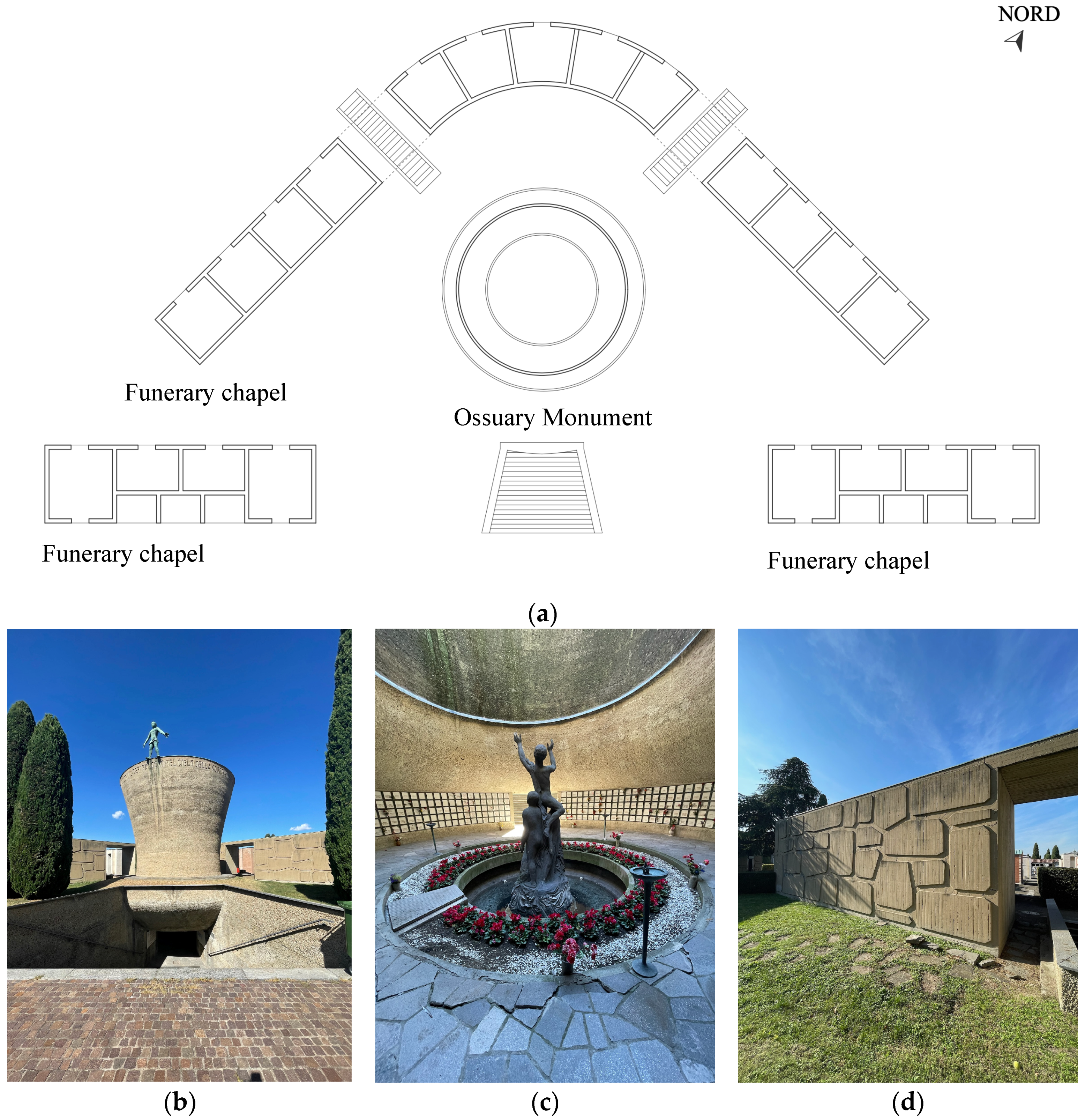
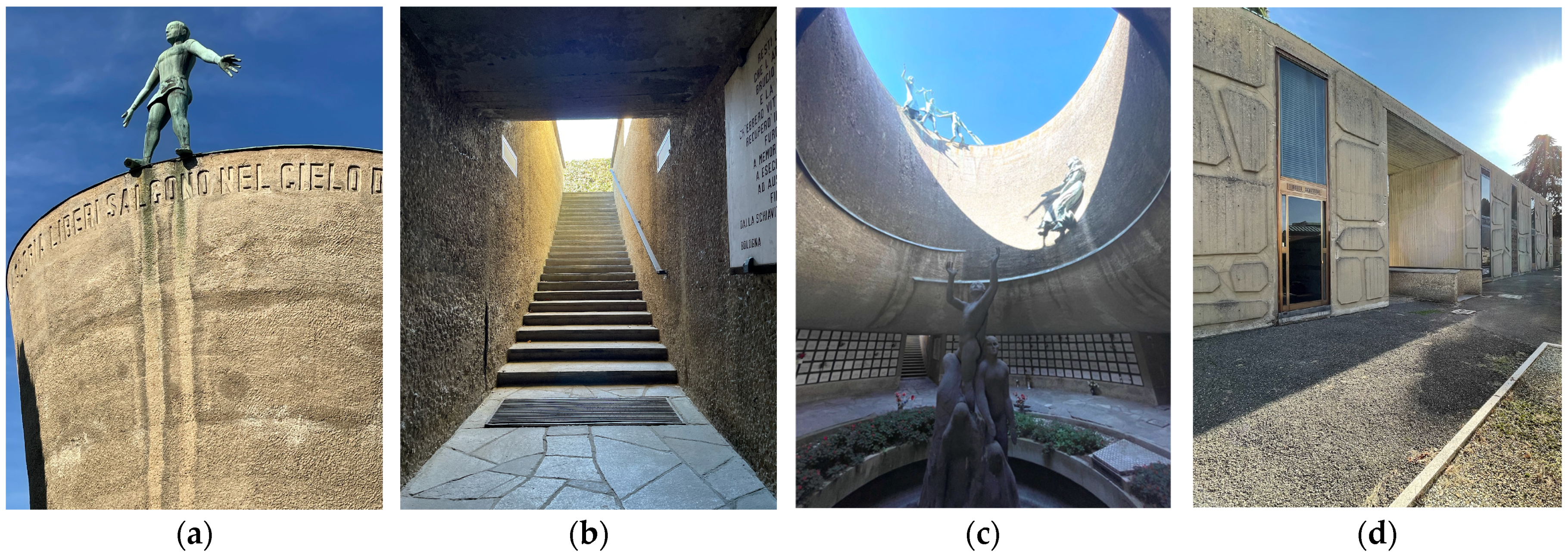
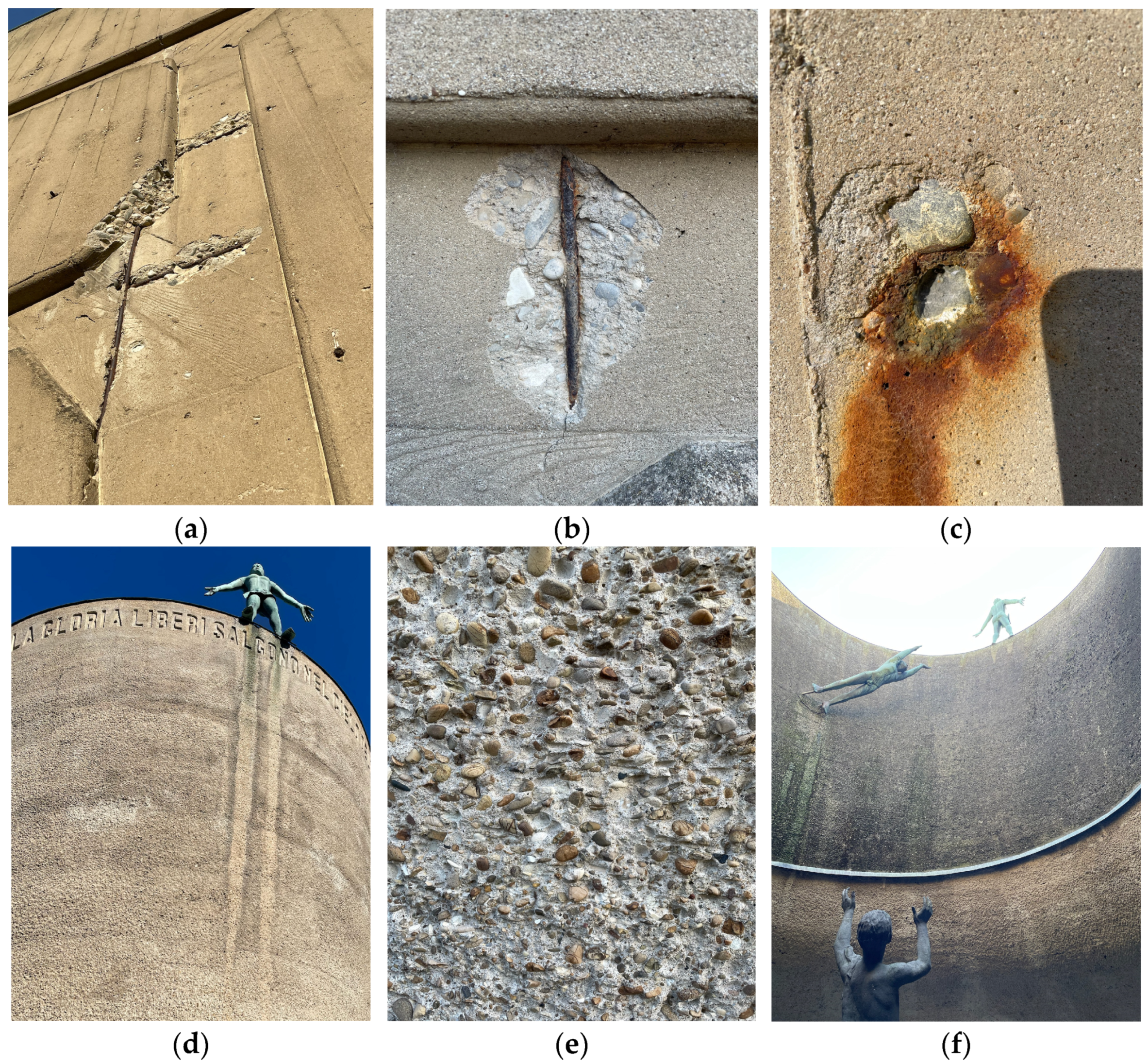
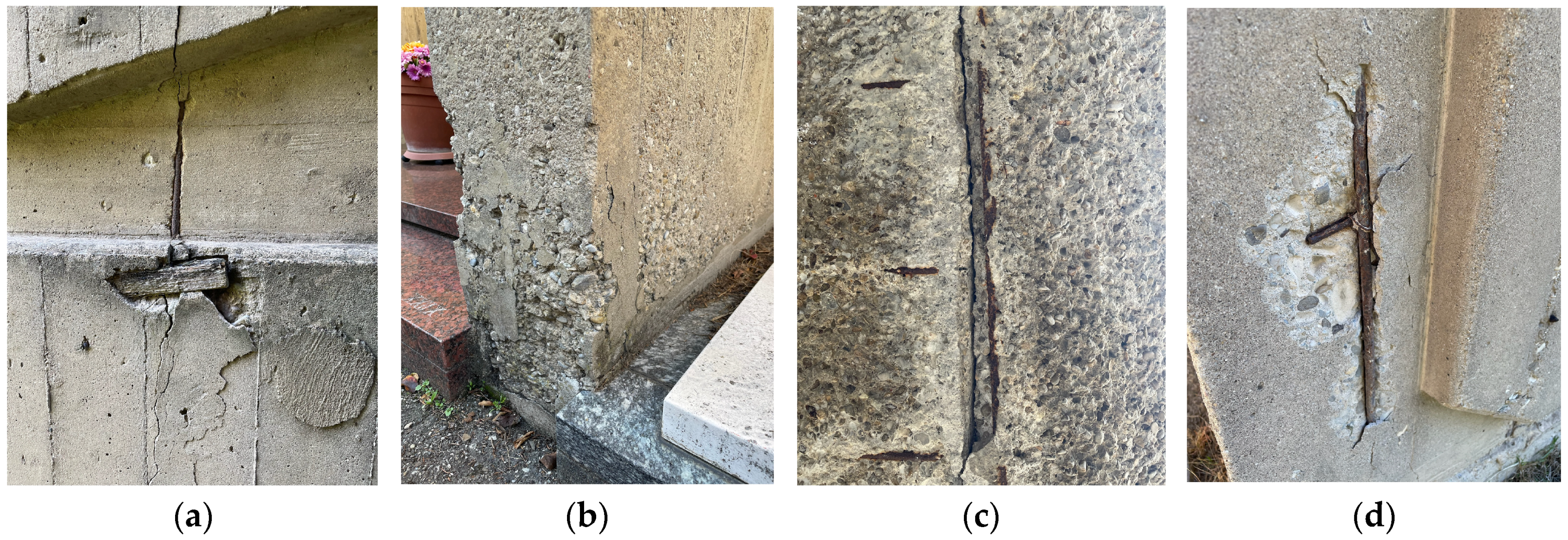
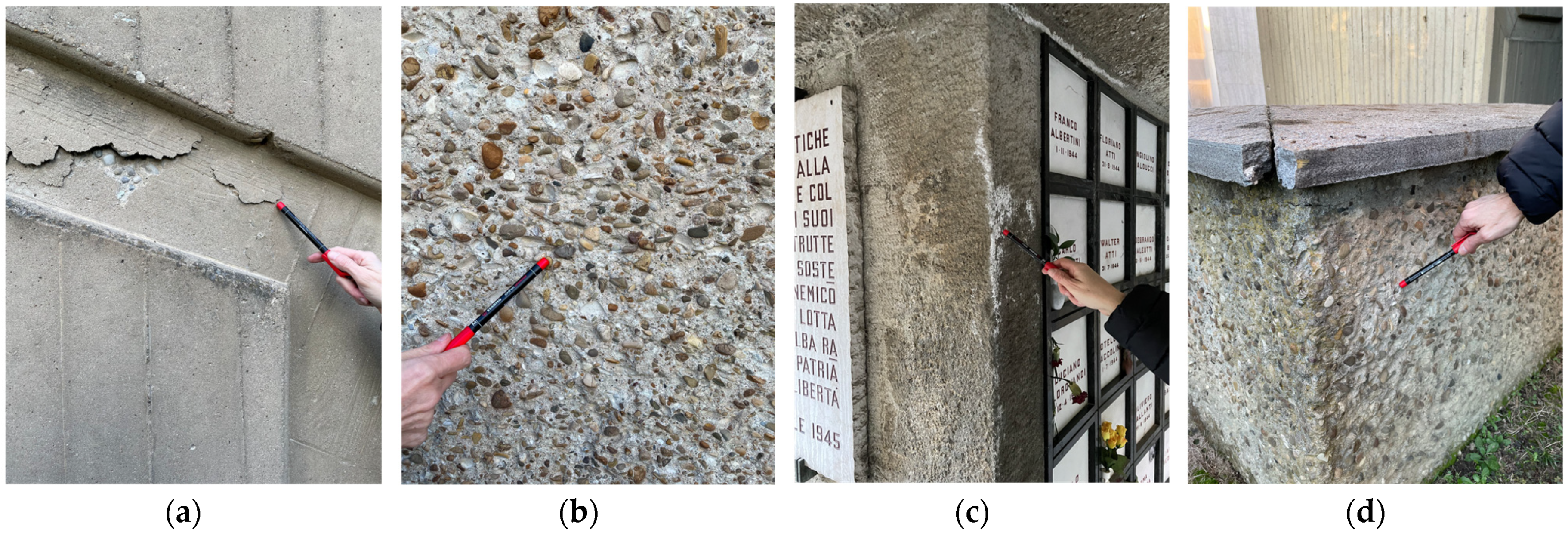
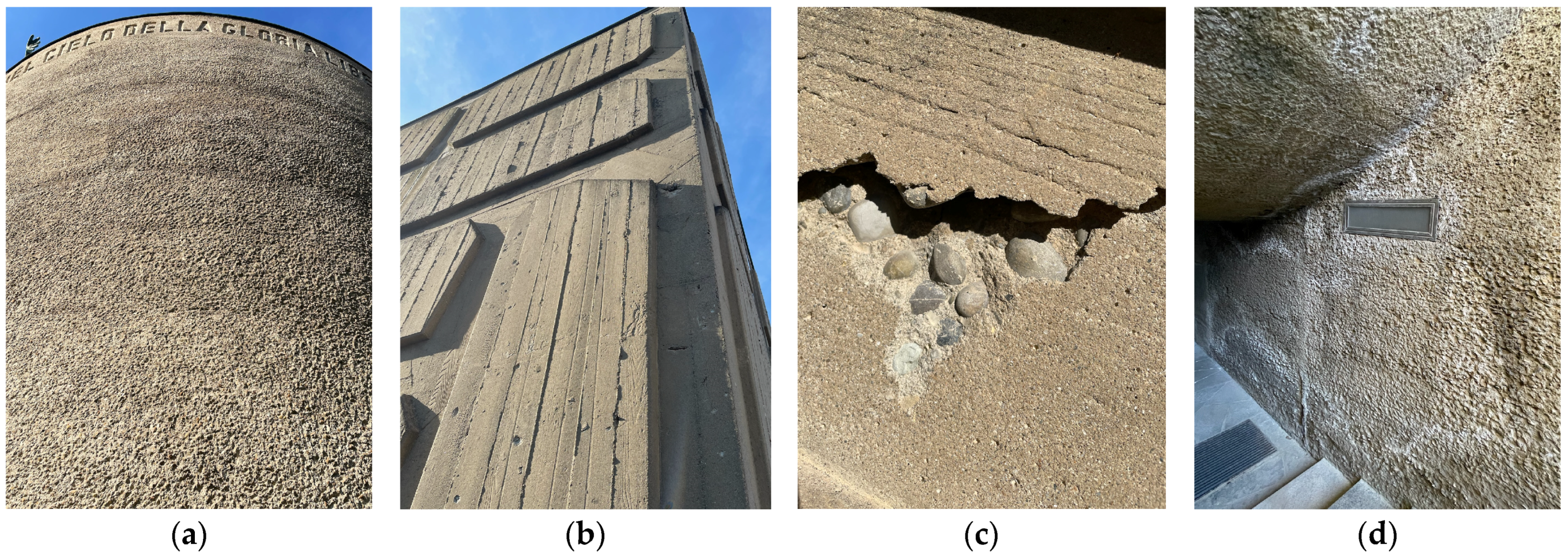

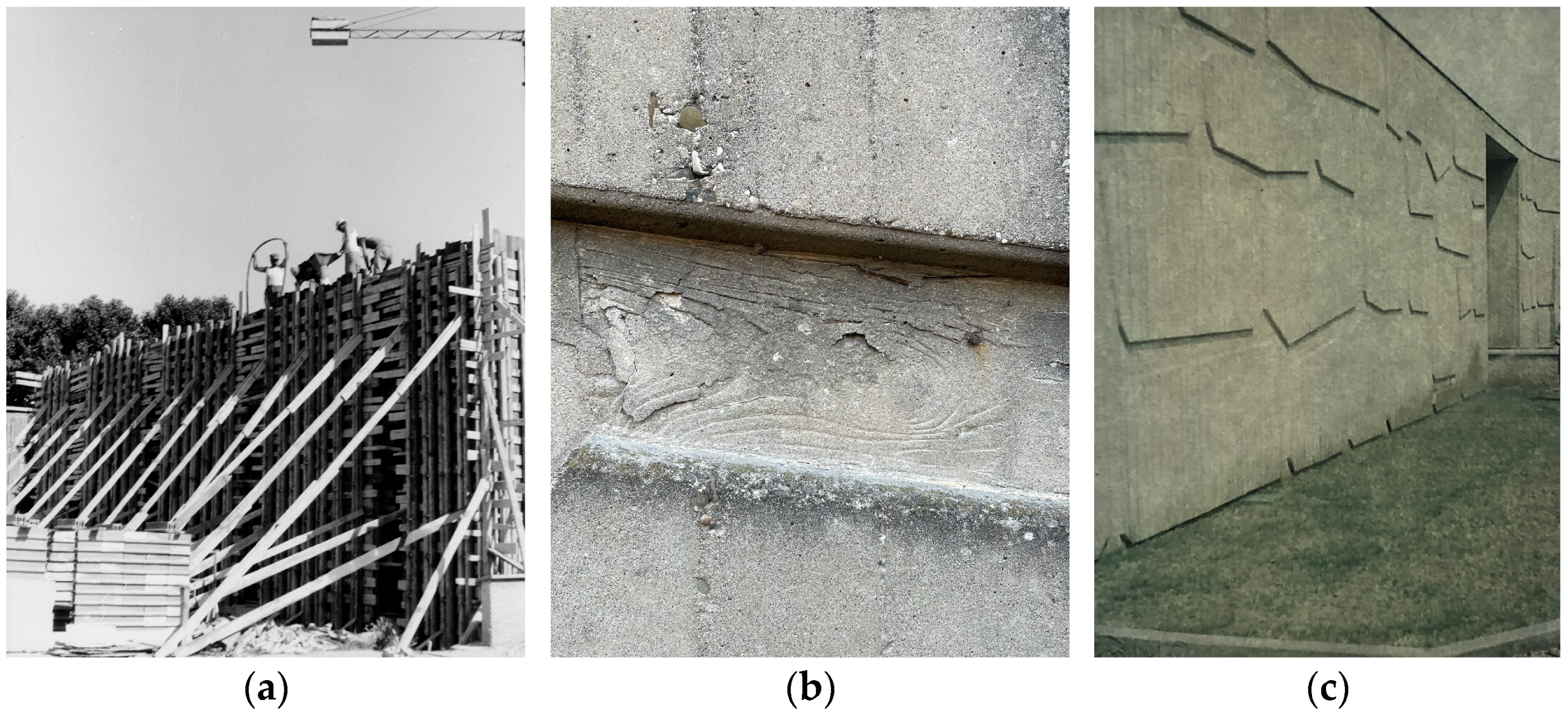
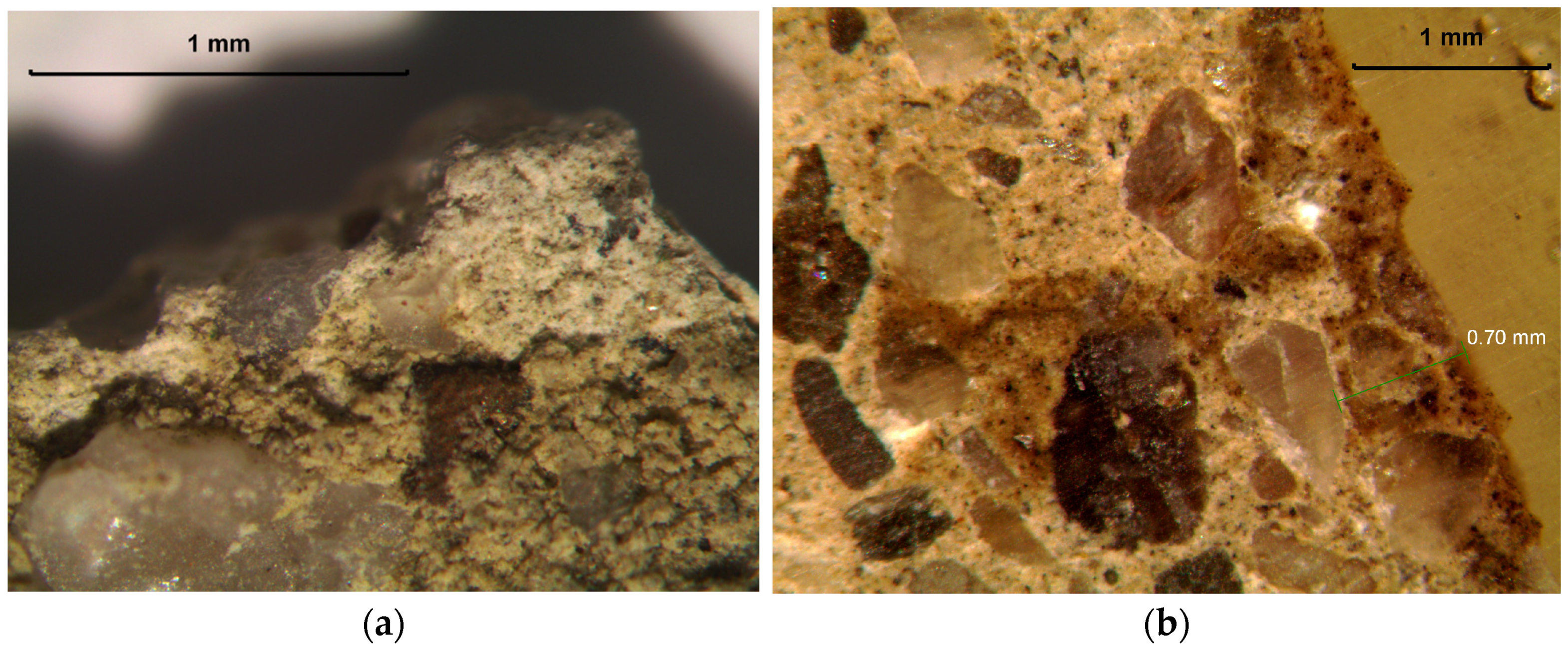
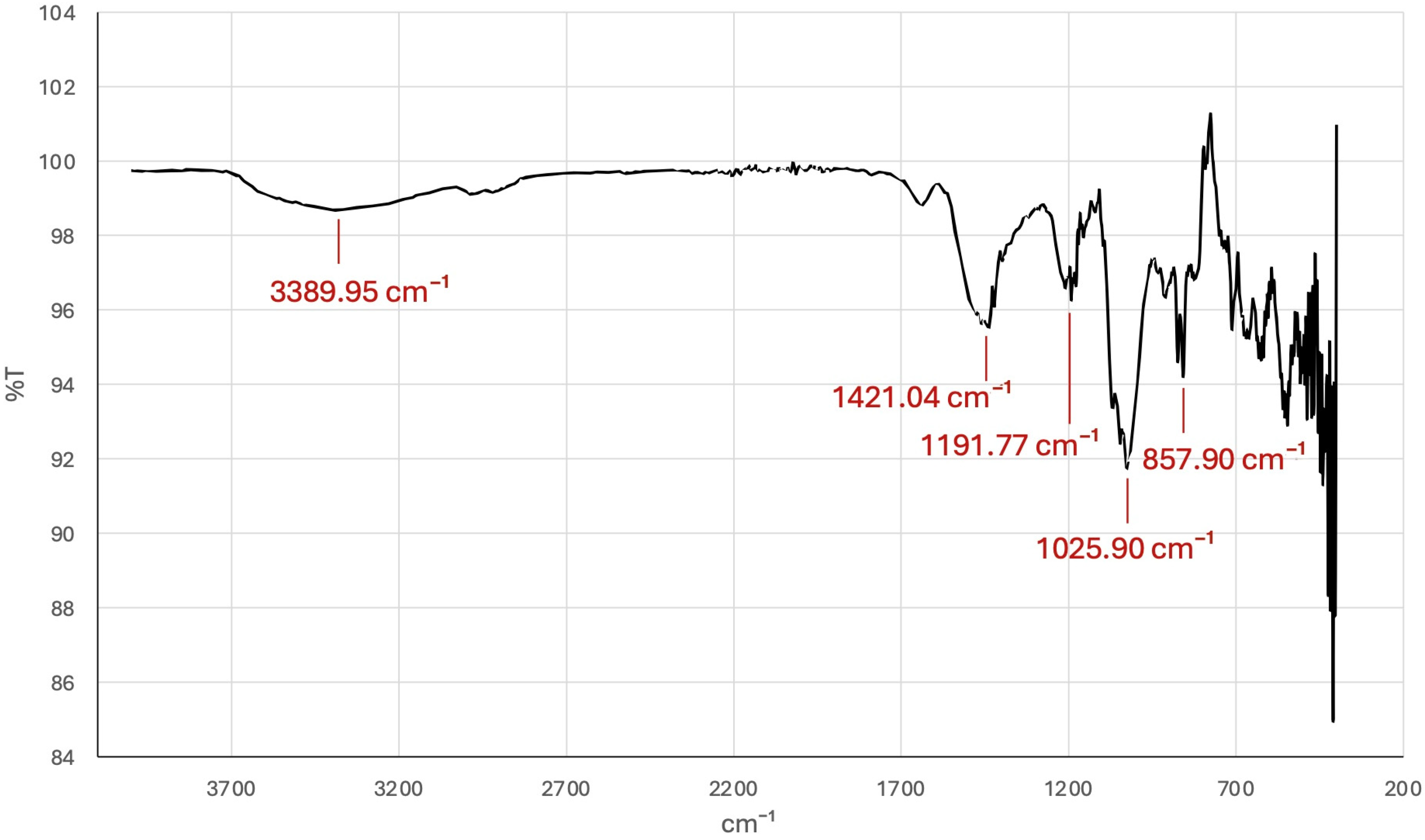
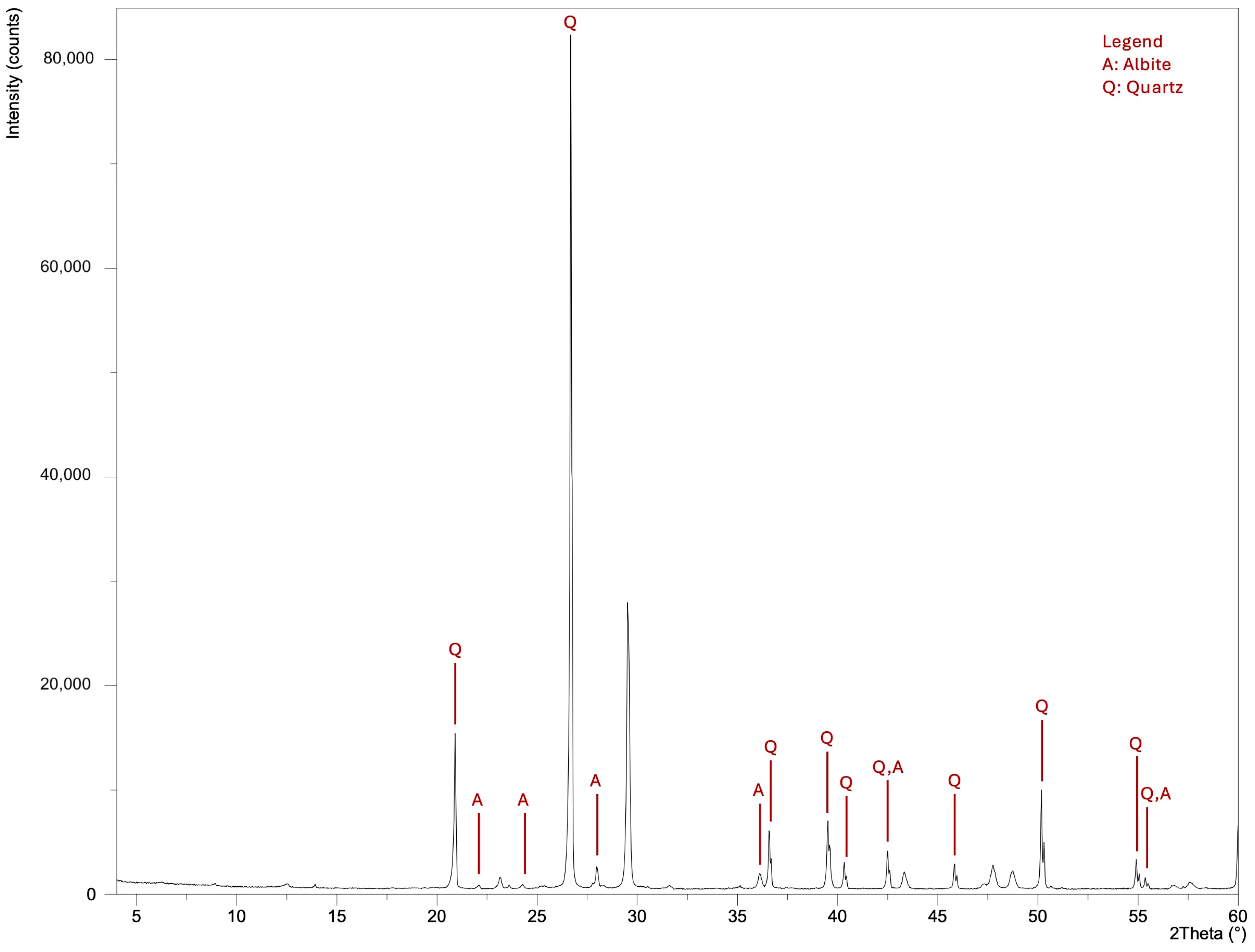

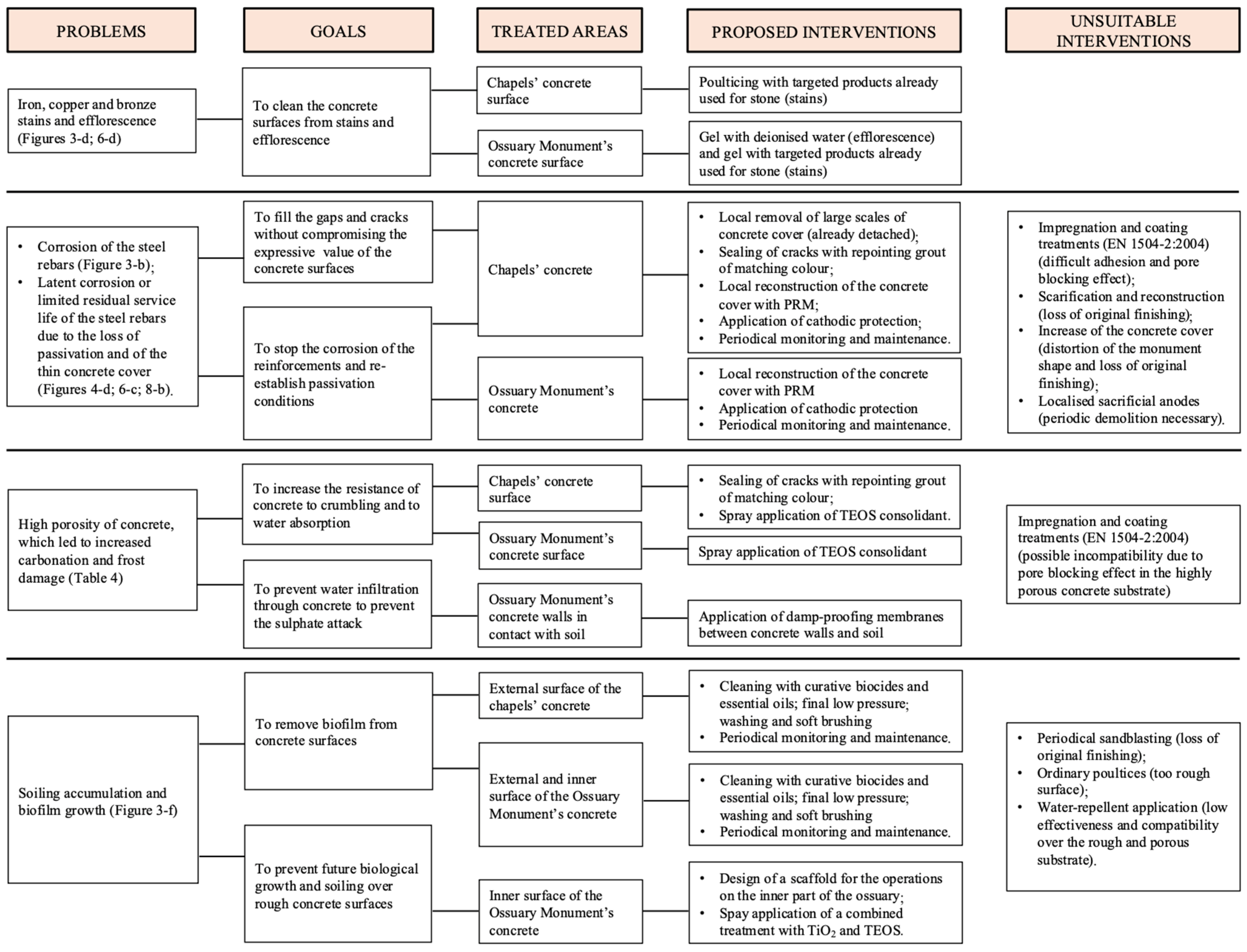
| Sample Number | Description | Sampling Location |
|---|---|---|
| 1, 2 | fragments of the concrete cover | funeral chapels |
| 3 (a, b) | concrete: (a) aggregates and (b) cement mortar fraction | external surface of the Ossuary Monument |
| 4, 5, 6 | white salt efflorescence | different areas of the underground crypt |
| 7 | concrete: cement mortar fraction | external surface of the West staircase that leads to the crypt |
| Samples | Cl− (%) | NO3− (%) | SO4− (%) |
|---|---|---|---|
| 3b | 0.038 | 0.004 | 0.049 |
| 7 | 0.062 | 0.012 | 0.057 |
| Samples | Cl− (%) | NO3− (%) | SO4− (%) |
|---|---|---|---|
| 4 | 0.072 | 0.214 | 7.176 |
| 5 | 0.341 | 0.135 | 35.57 |
| 6 | 0.085 | 0.157 | 17.82 |
| Samples | WA (%) | |
|---|---|---|
| 1 (concrete cover) | Fragment 1 | 12.0 |
| Fragment 2 | 9.3 | |
| 2 (concrete cover) | Fragment 1 | 11.2 |
| Fragment 2 | 10.2 | |
| 3b (mortar fragment) | Fragment 1 | 13.3 |
| Fragment 2 | 9.0 | |
| 7 (mortar fragment) | Fragment | 8.5 |
Disclaimer/Publisher’s Note: The statements, opinions and data contained in all publications are solely those of the individual author(s) and contributor(s) and not of MDPI and/or the editor(s). MDPI and/or the editor(s) disclaim responsibility for any injury to people or property resulting from any ideas, methods, instructions or products referred to in the content. |
© 2025 by the authors. Licensee MDPI, Basel, Switzerland. This article is an open access article distributed under the terms and conditions of the Creative Commons Attribution (CC BY) license (https://creativecommons.org/licenses/by/4.0/).
Share and Cite
Sermasi, L.; Franzoni, E. New Challenges in the Conservation of Fair-Faced Reinforced Concrete with Aesthetic Value: The Lessons from an Italian Brutalist Monument. Heritage 2025, 8, 152. https://doi.org/10.3390/heritage8050152
Sermasi L, Franzoni E. New Challenges in the Conservation of Fair-Faced Reinforced Concrete with Aesthetic Value: The Lessons from an Italian Brutalist Monument. Heritage. 2025; 8(5):152. https://doi.org/10.3390/heritage8050152
Chicago/Turabian StyleSermasi, Linda, and Elisa Franzoni. 2025. "New Challenges in the Conservation of Fair-Faced Reinforced Concrete with Aesthetic Value: The Lessons from an Italian Brutalist Monument" Heritage 8, no. 5: 152. https://doi.org/10.3390/heritage8050152
APA StyleSermasi, L., & Franzoni, E. (2025). New Challenges in the Conservation of Fair-Faced Reinforced Concrete with Aesthetic Value: The Lessons from an Italian Brutalist Monument. Heritage, 8(5), 152. https://doi.org/10.3390/heritage8050152








